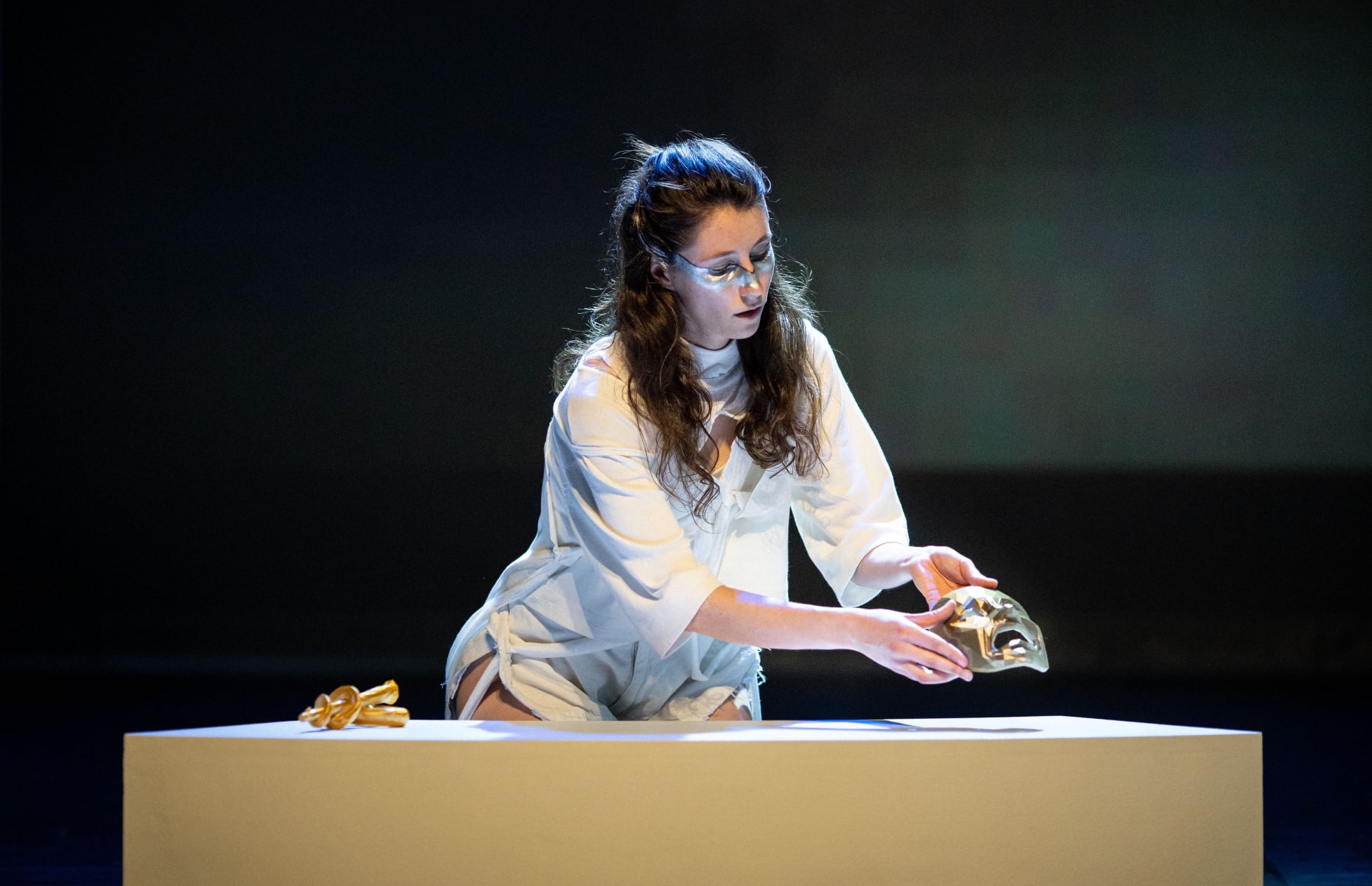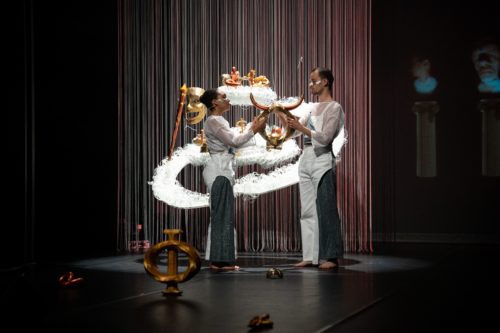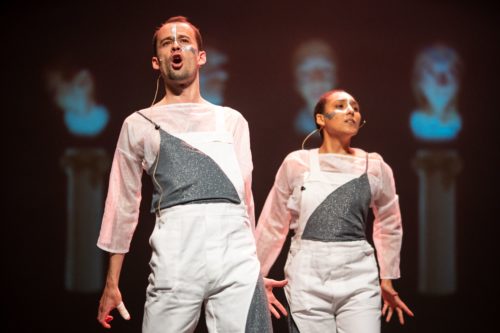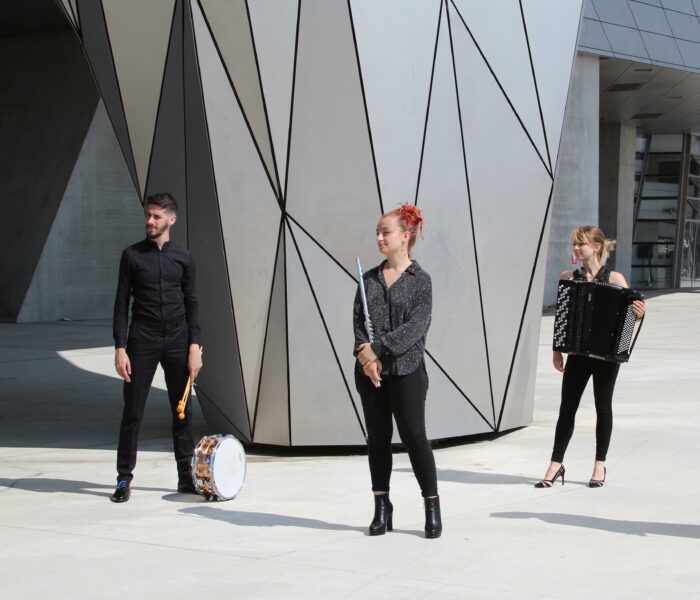Demian Rudel Rey ne se contente pas d’écrire de la musique… L’aspect visuel le passionne également ainsi que le traitement de l’image à l’instar de celui du son. Pour son premier opéra de chambre Qu’est-ce-que l’amour? convoquant chanteurs, instrumentistes-acteurs, danse, vidéo et électronique, le jeune compositeur argentin réalise un film dont la création en ligne est disponible jusqu’au 27 février à 23h59.
Qu’est-ce que l’amour? a été créé en version scénique au Théâtre de la Renaissance à Lyon le 30 avril 2021. C’est un projet réalisé dans le cadre du cursus de troisième cycle « Artist Diploma créations » du Conservatoire National Supérieur de Musique de Lyon, projet pour lequel le compositeur dit avoir pris tous les risques : de fait, la proposition est ambitieuse (du Platon dans le texte), un dispositif pléthorique (acoustique et électronique, vidéo et danse) et des idées profuses (la mise en scène un rien « baroque » de Juliette Müller Kos) : tel est l’enjeu du spectacle qui consiste, selon les mots de Demian Rudel Rey, à établir « une vraie consonance et dialectique entre musique, vidéo, électronique, danse et livret », une expérience interdisciplinaire un peu folle portée à bout de bras par une équipe bien soudée.
Il s’agit pour le librettiste Éric Dayre (professeur de littératures comparées à l’ENS de Lyon) de recréer l’atmosphère de ces nuits festives animées par les joutes oratoires des convives philosophes telles que les relate Platon dans son Banquet (380 av.JC) : Socrate (la danse/Héloïse Larue) est ici le point de mire, celui que chacun veut séduire à travers son discours sur l’Amour. De Phèdre à Pausanias, d’Aristophane à Eryximaque, d’Agathon à Diotime et Alcibiade, chacun expose sa propre vision d’Eros, engageant une réflexion sur les origines du monde et l’interaction des dieux et des hommes à travers autant d’hypothèses, de légendes mythiques et de vues de l’esprit. Relecture et réécriture sont à l’œuvre dans un livret élaboré sur mesure et dans un dialogue constant avec le compositeur et ses propres perspectives.
Chose encore bien inhabituelle aujourd’hui, les musiciens (clarinette, saxophone, accordéon/bandonéon, tuba, percussions, chanteurs) et le chef (le compositeur lui-même) sont également acteurs, endossant le rôle de chacun des philosophes puis revenant sur scène avec leur instrument respectif, en solo ou avec leurs partenaires. Dans cette vision de l’antique où plane l’ombre de la Tragédie grecque, le blanc domine, dans les costumes comme dans les éléments de scénographie, n’était ce bleu Klein des lumières (celles de Rocío Cano Valiño) qui embrase le sol ainsi que le fond de scène.
L’opéra est conçu par numéros, enchaînant avec fluidité quatorze scènes où apparaissent à tour de rôle les sept orateurs/chanteurs (Agathon étant incarné par un duo de soprano et baryton) dans un espace où va évoluer la danseuse (Héloïse Larue également chorégraphe). L’ouverture donnée par l’ensemble instrumental et les deux chanteurs, tous maquillés, sollicite la vidéo et le traitement de l’image qui ne manque pas d’humour, où se profilent les huit invités du banquet. On parle mais aussi on mange, des fruits en l’occurrence (et chacun le sien), dans une mise en scène mettant également dans les mains des personnages des accessoires, thyrse, masque, casque, etc. : autant d’objets symboliques qui apparaissent sur la vidéo en 3D et autant d’allers retours entre la scène et l’écran dans une ambiguïté recherchée du réel et du virtuel. Cette dualité se retrouve au sein de la musique, louvoyant entre l’ensemble instrumental, dirigé par le compositeur, et la partie électronique, sons fixés sur support et traitement live dont il faudrait souligner toutes les sophistications.
Reste le problème sensible du musicien-acteur qui n’a certes pas l’envergure du comédien ni le métier pour tenir seul la scène, même si les six instrumentistes à l’oeuvre, qu’il faut tous citer (Sergio Menozzi, clarinettiste/Alcibiade, Rémi Tripodi, saxophoniste/Aristophane, Côme Boutella, tubiste/ Pausanias, Louis Domallain, percussionniste/Eryximaque, Lisa Heute, accordéoniste-bandonéoniste/Diotime, Demian Rudel Rey/Phèdre), sont vaillants et fort investis dans leurs rôles respectifs. Cette difficulté n’échappe pas au compositeur, confronté lui-même au texte à dire (très, trop long), qui prend souvent le parti de traiter la voix parlée ou de la faire passer à travers les haut-parleurs pour rejoindre l’univers du sonore et mieux la fondre avec le support électroacoustique qui l’accompagne : une bonne décision, semble-t-il, qui mériterait d’être creusée et plus assumée encore pour réaliser ce continuum entre le sens et le son relevant de l’utopie sonore du compositeur et parfaire ce « nœud borroméen », signalé dans la vidéo, entre les différentes actions du spectacle.
Michèle Tosi



)



